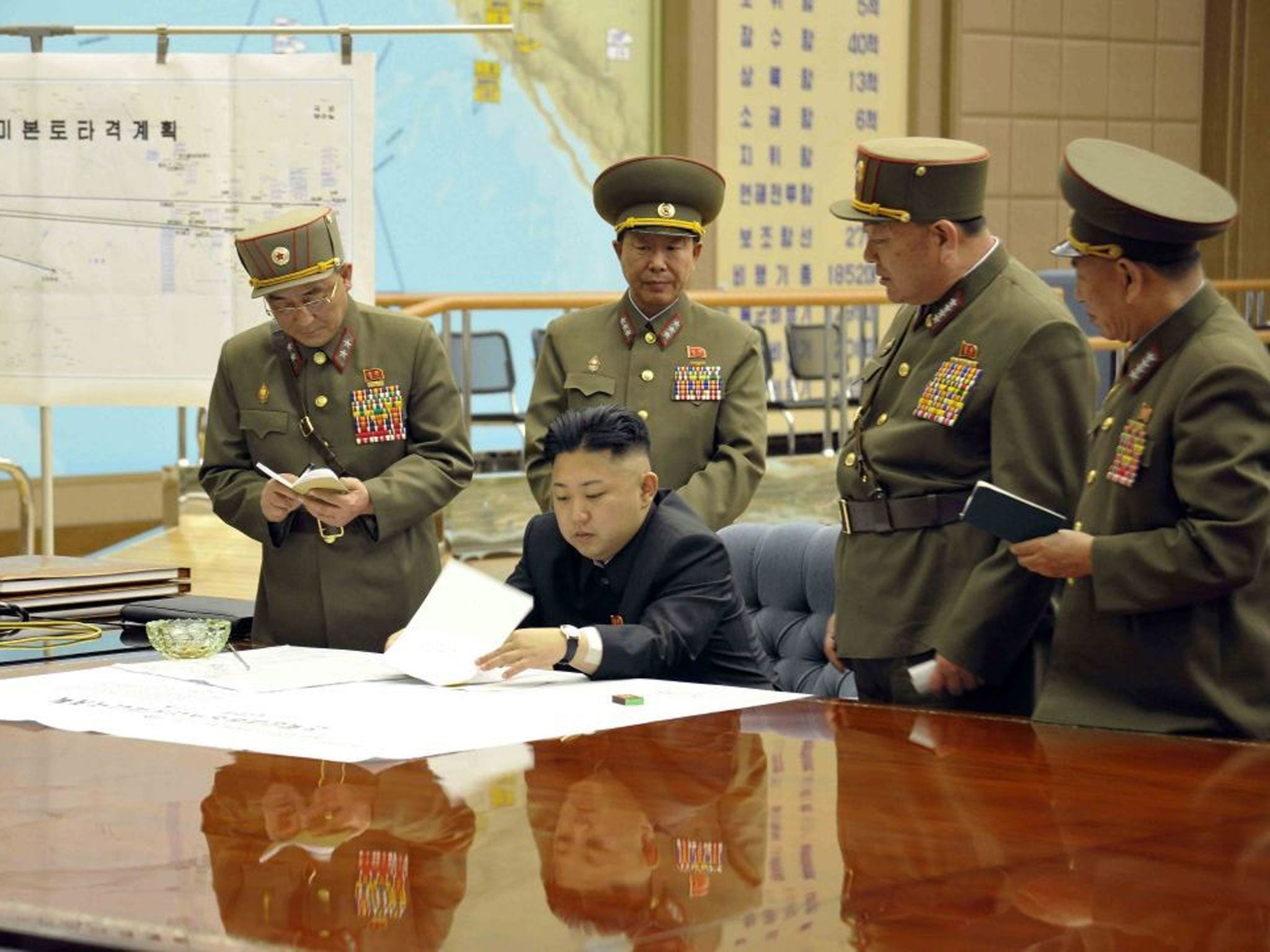North Korea 'readies rockets to attack United States targets'
Kim Jong-un responded to use of the B-2 bombers by the United States by saying his rocket forces were ready 'to settle accounts with the US'

American and South Korean intelligence officials were watching for unusual troop or hardware movements in North Korea tonight hours after the country’s leader, Kim Jong-un, publicly ordered that his rocket arsenals be readied to strike at targets including military bases in the Pacific and the United States mainland.
There is doubt whether North Korean missiles could reach the western seaboard of the US or even Hawaii, but no one is ready to ignore the sudden spike in belligerent rhetoric. Earlier this month US Defence Secretary Chuck Hagel announced that $1bn would be spent strengthening America’s ballistic missile interception system in Alaska. North Korea possesses Soviet-era Scud missiles that could reach Seoul, while its long-range weapons could bring American bases in Guam and Okinawa, Japan, into range.
“If they make a reckless provocation with huge strategic forces, [we] should mercilessly strike the US mainland, their stronghold, their military bases in the operational theatres in the Pacific, including Hawaii and Guam, and those in South Korea,” the North Korean news agency reported yesterday. It cited Kim Jong-un decreeing that the “time has come to settle accounts with the U.S. imperialists in view of the prevailing situation”.
The North Korean President has been issuing increasingly fiery statements in recent days as the US and South Korea have conducted joint military drills on the peninsula, which included America flying two of its B-2 stealth bombers from a base in Missouri to drop dummy bombs on an uninhabited South Korean archipelago. The UN tightened sanctions on North Korea following a three-stage missile launch last December and an underground nuclear device explosion in February, while America and countries including Japan and Australia have also recently imposed new economic sanctions on Pyongyang.
The rising tensions were evident on the streets of the North Korean capital yesterday, where thousands gathered, punching their fists in the air and chanting “death to the US imperialists”.
Earlier last week Pyongyang announced it was ending its compliance with the nearly 60-year-old armistice that ended the Korean War and severing a military communications hotline with the South. While statements about targeting US bases in the region and South Korea also trickled out last week, the threat was given more force yesterday because for the first time it was delivered personally by the President.
Seoul confirmed it was monitoring the North closely. “We believe they are taking follow-up steps,” said Kim Min-seok, spokesman of the South Korean Defense Ministry, alluding to movements of North Korean military units.
Images released by the state-run KCNA news agency showed the leader, who took over when his father, Kim Jong-Il, died suddenly in 2011, in a military situation room apparently signing the order to put the weapons on standby. On the wall is a map entitled “Strategic Forces’ US Mainland Striking Plan”, showing missile trajectories heading towards Washington DC, Los Angeles and, oddly, Austin, Texas.
“North Korea continues to openly threaten the United States,” the Chairman of the Homeland Security Committee, Michael McCaul, said in Washington yesterday. “While it is unlikely that the regime has the capability to carry out its plots, we still cannot ignore its violent intentions. We must remain vigilant against this escalating enemy.”
China, which ostensibly remains North Korea’s only ally, urged restraint while making no mention of the flight of the B2 bombers. Moscow was less circumspect. “We are concerned that alongside the adequate, collective reaction of the UN Security Council, unilateral action is being taken around North Korea that is increasing military activity,” Foreign Minister Sergei Lavrov said, adding: “The situation could simply get out of control.”
US allies in the region that could be threatened by North Korea should be reassured by the B-2 over-flights, officials said. “The reaction to the B-2 that we’re most concerned about is not necessarily the reaction it might elicit in North Korea, but rather among our Japanese and Korean allies,” Gen. Martin Dempsey, chairman of the Joint Chiefs of Staff, said at the Pentagon. “Those exercises are mostly to assure our allies that they can count on us to be prepared and to help them deter conflict.”
Nations refuse to sign 'flawed' arms treaty
AP
Iran, Syria and North Korea have blocked the adoption of the first international treaty to regulate the $70bn global conventional arms trade, complaining that it was flawed and failed to ban weapons sales to rebel groups.
UN member states began meeting last week in a push to hammer out a binding international treaty to end the lack of regulation over cross-border conventional arms sales.
Human rights groups say a treaty is needed to halt the uncontrolled flow of arms that they say fuels wars and rights abuses. Delegates to the conference said they were close to approving the treaty, before Iran, Syria and North Korea blocked it.
Join our commenting forum
Join thought-provoking conversations, follow other Independent readers and see their replies
Comments